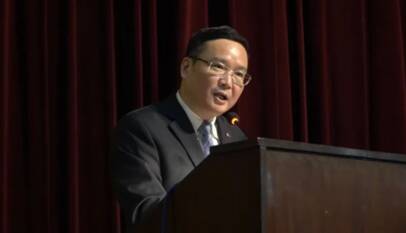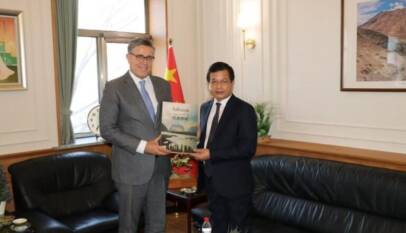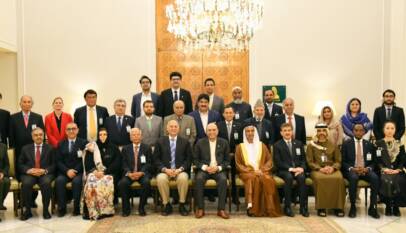China to cooperate with Pakistan for buffalo milk
While talking to China-Pakistan Agricultural and Industrial Cooperation Information Platform (CPAIC), President of Royal Group, Chen Yiyi said that in order to enhance cooperation with Pakistan in its rich buffalo milk, China hopes to set up a dairy processing plant in Pakistan. Moreover, Gu Wenliang, Agriculture Commissioner of the Chinese Embassy in Pakistan, said that Pakistan is the fourth largest milk producer in the world, with buffalo milk accounting for 60%. Dr Khurshid Ahmad, Animal Husbandry Commissioner of the Ministry of National Food Security and Research said that it is not allowed in Pakistan to export live animals, so China will have to find a new way of getting Pakistani buffaloes milk.
BEIJING:
“Pakistan is rich in buffalo breeds, buffalo research, and buffalo milk production. To leverage its advantages and enhance Pakistan-China cooperation in this field, we hope to set up a dairy processing plant in Pakistan,” Chen Yiyi, President of Royal Group, told China-Pakistan Agricultural and Industrial Cooperation Information Platform (CPAIC) after completing a week-long visit to Pakistan.
What’s so special about Pakistan’s buffalo milk? Will Pakistan’s buffalo enter China again after nearly 50 years? How will China and Pakistan tap their complementary advantages in the buffalo industry to expand production capacity?
Bearing a few questions in mind, a reporter of CPAIC interviewed members of a Chinese delegation, led by the Royal Group.
Gu Wenliang, Agriculture Commissioner of the Chinese Embassy in Pakistan, told the reporter that Pakistan is the fourth largest milk producer in the world, with buffalo milk accounting for 60%.
There are 41 million buffaloes in Pakistan and milk yield is higher than that in China. According to an Economic Survey report of Pakistan’s government, in fiscal year 2019-20, the output of buffalo milk in Pakistan reached 256,000 tons.
Pakistan’s buffalo milk is rich in flavour and fat. The official website of Guangxi Buffalo Research Institute showed that the dry matter content of buffalo milk accounts for 18.4%, much higher than that of ordinary milk, the fat percentage and protein of buffalo milk reach 7.9% and 4.5% respectively, which are higher than the average values of 3.82% and 3.25% of raw milk in China (from the China Dairy Association).
In 1974, Pakistan gifted 50 Nili-Lafite buffaloes to China. Statistics provided by the Buffalo Research Institute show that the average milk yield of the first generation of Niza buffaloes, which was obtained by crossing the buffaloes of Pakistan with the Chinese native female buffaloes, was 2,083.8 kg, with the highest daily output of 13.4 kg.
However, with the passage of time, milk production declines year by year. Strengthening cooperation with Pakistan in the future is one of the ways for Chinese enterprises to maintain or expand the production of high-quality buffalo milk.
Whether Pakistan can export live buffalo is the focus of Chinese enterprises.
“It is not allowed in Pakistan so far to export live animals,” noted Dr Khurshid Ahmad, Animal Husbandry Commissioner of the Ministry of National Food Security and Research at a meeting held by CPAIC.
In this condition, the Chinese enterprise has to make a detour to import Pakistan’s buffalo oocytes and frozen sperm.
However, Pakistan is faced with several conundrums on the technological front. Pakistani insiders, who received the Chinese delegation, said due to limited domestic demand, the buffalo embryo breeding technology in Pakistan is falling behind and commercial export has not yet been realised.
Pakistan hopes to introduce Chinese buffalo embryo breeding technology and strengthen cooperation in buffalo breeding and export of high-quality frozen sperm and embryos.
“If regulations permit, we are willing to share China’s experience and embryo technology,” Chen said.
“In the foreseeable future, the rapid growth of animal husbandry will put more pressure on dairy producers, so it’s imperative for us to improve buffalo varieties through new technologies and work with Pakistani partners to promote the output of the entire animal husbandry industry.”
Chen highlighted that China’s practice in the animal husbandry industry over the past 30 years has shown that a proportional introduction of gene technology and embryo technology is conducive to the rapid growth of agricultural population and the improvement of population quality.
China’s experiences and technologies in this respect will be beneficial to the re-development and upgrading of Pakistan’s animal husbandry in terms of quality and quantity.
In addition to technological cooperation, “we are also willing to develop dairy product processing and industrial research in Pakistan to meet the demand of its domestic market and seek export to the Chinese and international markets. That will not only create foreign exchange reserves for Pakistan but will also enhance the competitiveness of China and Pakistan in milk and meat production in Asia,” Chen added.
Investment in processing plants is the first and foremost requirement to meet Pakistan’s domestic demand. Although Pakistan is a major milk producer, it still spends Rs20 billion every year to import milk and other dairy products.
According to the Economic Survey report of Pakistan’s government, 15% of Pakistani milk production was wasted due to improper transportation and lack of refrigeration equipment in fiscal year 2019-20.
According to the Pakistan Dairy Association, the export of dairy products and milk in Pakistan can actually reach $30 billion while the export value in fiscal year 2020 was only $680 million.
To improve the processing capacity of dairy products and reduce foreign exchange losses, “Pakistani governments at all levels have been dedicated to improving the investment environment in the past five years and that has facilitated investors,” Chen said.
Xiao Ziqi, a member of the delegation who is experienced in agricultural investment, said that in Pakistan the purchase price of pure buffalo milk is RMB 4-5 per kg, which varies slightly from region to region.
In contrast, the purchase price of buffalo milk in China is about 2-3 times that of Pakistan. In Guangxi province, a core producing area in China, the price has been increasing year by year, reaching nearly RMB 10-12 per kg, and once approached RMB 15 in peak season.
If Pakistan’s buffalo milk can be exported to China, it will not only add to Pakistan’s foreign exchange reserves but will also provide a more favourable price for Chinese consumers.
The window has been open to Pakistan for export. Pakistan’s dairy products and beef, which have been suffering from foot-and-mouth disease, may have two breakthroughs this year.
First, in February, China’s Huiyu Group and Nestle Pakistan signed a memorandum of understanding to import Nestle cream from Pakistan. Second, in April, a Pakistani company announced that it had been approved by China Customs to export 300 tons of beef after heat treatment to China. If it is done, it will become the first company in Pakistan to obtain such approval.
Royal Group is not the first Chinese dairy enterprise to enter Pakistan. With the construction of the China-Pakistan Economic Corridor, dairy companies such as Liaoyuan Dairy, Yili and Shengyuan have tried to lay out on Pakistan one after another with some giving up and some gaining a firm foothold.
Chen said that with the cooperation between the two governments further strengthening and the investment environment of Pakistan improving, “we think this is a more appropriate time to invest in Pakistan. In the next decade, buffalo milk will usher in more business opportunities.”
Chinese envoy Zhao Shiren urges students to uphold integrity and strengthen China-Pakistan ties
LAHORE:The Consul Generals from several countries and other distinguished guests attended …











